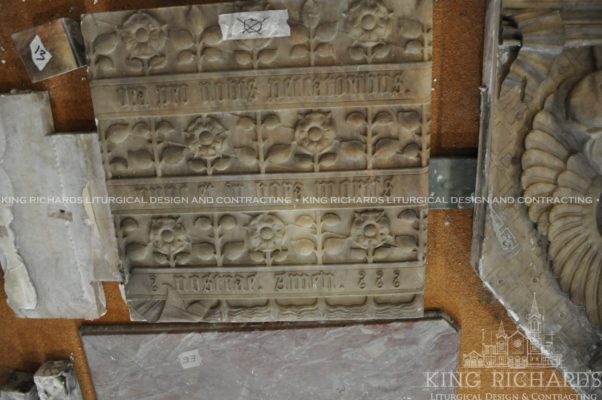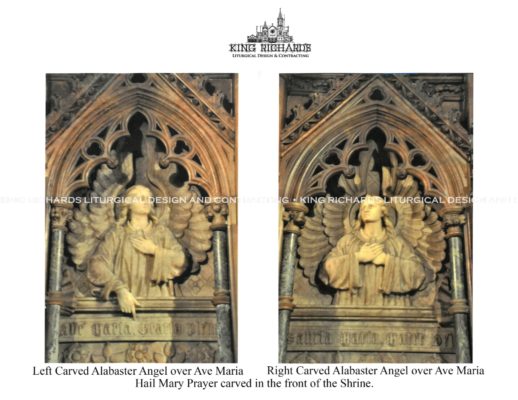High Altars/Reredos, Projects
Pugin designed art, George Harrisons place of Baptism and family parish. This Marian shrine (some would say side altar) is simply a great artifact from the late 1800s.
Project#: P-2034
Location: Liverpool, UK
Project Type: Atlars, Side Altars, Shrine, Pulpit, Removal
Pugin designed art, George Harrisons place of Baptism and family parish. This Marian shrine (some would say side altar) is simply a great artifact from the late 1800s.The details include all English alabaster and import marbles, all hand carved details, amazing pair of high relief Puginesque angels, The complete Hail Mary Prayer in Latin carved into the alabaster front under the angel and into the gradines. The quality of this piece of art is obvious throughout its tombstone size pieces of stone, it is self-supporting as the walls are 4-8 inches thick as well as the relief panels.
Most altars made after 1900-1910 are all one-inch veneers to save material cost and weight. Documenting English artifacts like this shrine are a total joy as the time and effort put into just getting, carving, and delivering the stone with horse and buggies would have been impressive in itself.
It exhibits EW Pugin details from top to bottom. The Church was designed in the 1870s, built in the 1880s and we have found documentation in archives that the Mary shrine was installed in 1901. EW Pugin died in 1875 and had an office close by this parish in Liverpool. The selection of colors and carvings on the ambo and Marian shrine seem to all point to EW. It was common for designs to be executed for pieces when the churches were built and then installed many years later.
This churches Hardman windows weren’t installed until 1890s by Hardman and Powell one by one over that decade. We have many pieces documented from Liverpool from AW and P and P Pugin of London as they passed the business down and their designs.
The size of this shrine is 13’ 8” high by 9 feet wide. It was designed and not installed or used a cross or finial on the top center canopy. Can be re-created.
The altar is filthy from 120 years candle suit, coal fired heating, windows always open for air in the very industrial city center of Liverpool and their historic docks.
The altars condition is exactly as how you would want to find it, history all over it. It will polish up like we don’t even know yet. Note some of pieces where we just wiped some of the grime off it to see the beautiful alabaster underneath.
Also, worth noting for starters here is the photo with our supervisor on site simply holding a small flash light behind the dome top, the this carving and transparency of the stone is remarkable.
People see similar stone, marble carvings, some alabaster, and details like this shine in many churches on the continent and Island of England. How often do you get a chance to have a historic piece of art like this as a shrine for your church or adoration chapel or private chapel?
See the pulpit from this church too at KRF-2436.





























